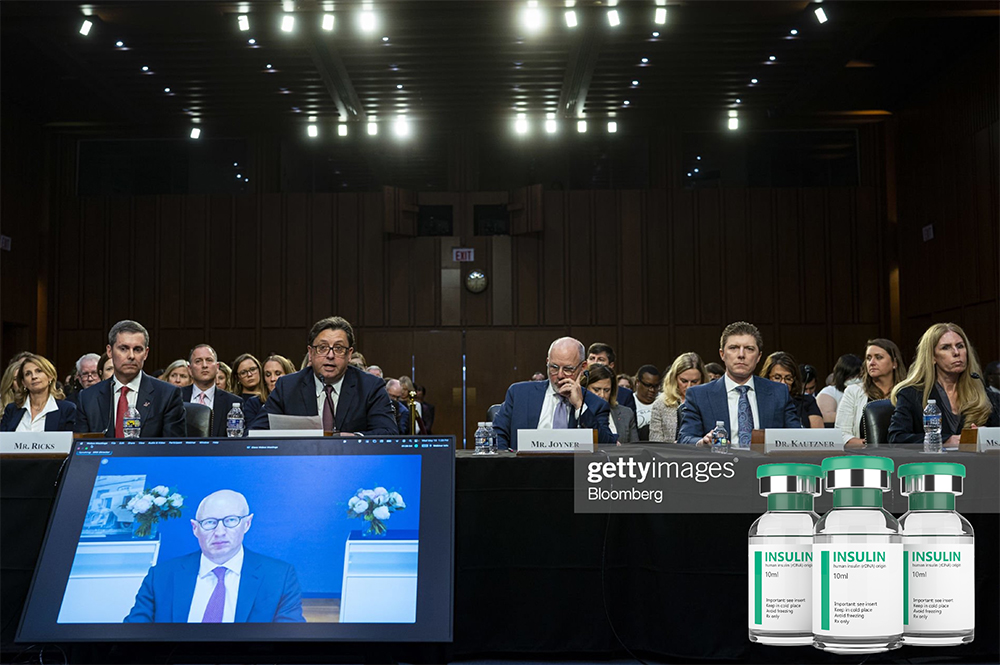Sen. Bernie Sanders’ hearing on insulin prices on Wednesday was indeed contentious, as we anticipated, but also surprisingly informative and polite.
Yes, top executives of pharmaceutical companies sparred with executives of pharmacy benefit managers (PBMs), pointing fingers over who is responsible for high insulin prices that consumers can encounter at the pharmacy. But in their sparring, they helped senators understand more about the incredibly complex system of drug pricing.
Executives of pharmaceutical companies and pharmacy benefit managers testified on Wednesday before a Senate Health, Education, Labor, and Pensions Committee hearing on insulin prices

Eli Lilly Chair and CEO David Ricks explained that “Lilly hasn’t raised the list price for any of our insulins since 2017, the year I became CEO. In fact, we’ve only cut them.” Their new biosimilar, Humalog, now available for $25 per vial.
Sanofi CEO Paul Hudson said the average net price of Sanofi’s top insulin drug is lower today than it was in 2004 and that his company “returned 84 percent of our gross insulin sales to payors as rebates.”
The drug companies also are frustrated that the lower-priced versions of their drugs seldom make it to PBM formularies. Senators questioned whether the PBMs prefer the higher prices because they get a percentage cut.
PBM executives replied they always prioritize the drugs with the lowest price in their complex negotiations with health plans, labor unions, and insurers and pass 98% of rebates along to the customers.
PBMs also are revising their formulary schedules to further reduce at-the-counter prices to patients “with an average member out-of-pocket cost below $9 for a 30-day supply of medication,” according to David Joyner, EVP of CVS Health and President, CVS Caremark.
“Today, more than 90% of the prescriptions dispensed are generics and represent a little more than 18% of total spend. And by using competition, generic prices have been deflationary over the last decade,” he said. “Securing affordability for the final 10% of name brand drugs is our focus.”
Sen. Roger (Doc) Marshall (R-KS) talked about the risks that more government intervention could impede innovation into better products—innovations that continue to extend the life expectancy of diabetics.
The first insulins had to be injected multiple times during the day and night, with needles that had to be sharpened, boiled, and reused repeatedly.
“The fact is that competition has produced better and better insulin products over time, and we are now seeing prices come down too,” according to Theo Merkel of the Paragon Health Institute in an article for National Review. “Congress should try to address narrow affordability problems where they exist but refrain from soundbite solutions that undermine competition in the long term.”
But that is what the HELP committee did on Thursday, marking up several bills designed to boost competition for generic drugs and increase transparency around PBMs and the insurers that use them. Sen. Rand Paul (R-KY) argued that the committee’s bills are likely to backfire and result in even higher prices.
The Biden administration repealed a Trump administration solution that addressed the examples Sen. Sanders and others raised about patients with lower incomes and no insurance suffering and even dying because they can’t afford their insulin.
“A little-noticed policy that would have more directly helped the narrow population that is uninsured or still pays over $35 per prescription was repealed by the Biden administration with little fanfare,” Merkel writes.
“The Trump administration finalized a rule requiring the nearly 1,400 federally qualified community health centers (FQHCs), which are clinics funded by the federal government to provide community care, to make available insulin at the heavily discounted price they receive under the 340B program (often under $15 per vial) to anyone under 350 percent of the poverty line (roughly $51,000 for a single person).”
The option was shut down.
Despite a sophisticated airing during the hearing of the complex pricing structures and generous patient assistance programs the drug companies offer that even give drugs away to those in need, Sanders concluded by saying “There is an enormous amount of greed in the system.”
Yes, Americans pay more than other countries with strong price controls and restrictions on access to new drugs, an issue that could and should be addressed in international trade negotiations.
We can only hope that competition will be allowed to progress without further government intervention that impedes new entrants and continued innovation. And that legislators will turn their sights on the abuses of the 340B program and Medicaid rebates that require manufacturers to sell their products at below cost—putting pressure on private payers to fill the gap.

